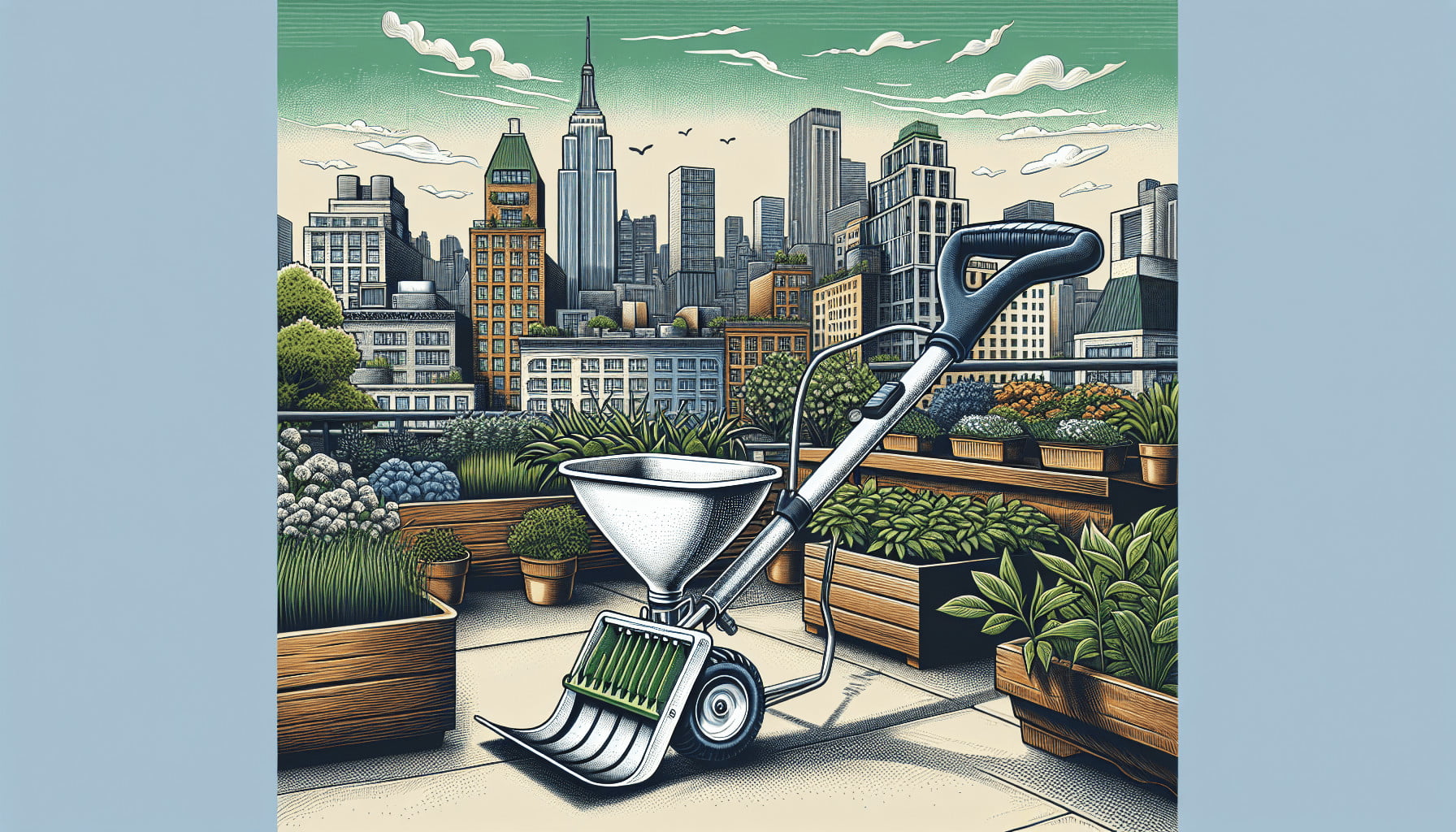Have you ever wondered how to keep your rooftop garden thriving with lush vegetation and healthy blooms? Fertilizing is key, and using the right fertilizer spreader can make all the difference. Whether you’re a seasoned gardener or just starting your rooftop garden adventure, knowing which spreader will best meet your needs can make the task efficient and even enjoyable.
Understanding the Importance of Fertilizer Spreaders
Fertilizer spreaders are essential tools for evenly distributing nutrients across your rooftop garden. Uneven application can lead to patchy growth, nutrient deficiencies, or even plant death. By choosing the right spreader, you ensure that every plant receives the nutrients it needs to flourish.
Advantages of Using Fertilizer Spreaders
- Efficiency: Manual spreading can be inconsistent and time-consuming. Spreaders cover large areas quickly and evenly.
- Even Distribution: Prevents over-fertilizing and under-fertilizing, promoting uniform growth.
- Time-Saving: Especially useful for large rooftop gardens, reducing the time spent on maintenance.
Types of Fertilizer Spreaders
There are several types of fertilizer spreaders, each suited for different needs and garden sizes. The main categories include broadcast spreaders, drop spreaders, handheld spreaders, and liquid fertilizer spreaders.
Broadcast Spreaders
Broadcast spreaders are ideal for larger rooftop gardens. They work by spreading fertilizer in a fan-like pattern, covering a wide area.
| Advantages | Disadvantages |
|---|---|
| Covers large areas quickly | Less control over spread direction |
| Suitable for granular fertilizer | Can be messy |
| Efficient for large gardens | Requires careful calibration |
Drop Spreaders
For those who prefer precision, drop spreaders are the way to go. They release fertilizer directly beneath the spreader, allowing for more accurate application.
| Advantages | Disadvantages |
|---|---|
| Precise application | Slower than broadcast spreaders |
| Less waste | Not suitable for very large areas |
| Excellent for small spaces | Requires more passes |
Handheld Spreaders
If your rooftop garden is relatively small or you prefer a more hands-on approach, handheld spreaders offer great control and simplicity.
| Advantages | Disadvantages |
|---|---|
| Easy to use | Limited capacity |
| Perfect for small gardens | Manual effort required |
| Affordable | Can be tiring for larger areas |
Liquid Fertilizer Spreaders
These spreaders are used in conjunction with liquid fertilizers and are known for their ability to provide rapid nutrient uptake by plants.
| Advantages | Disadvantages |
|---|---|
| Fast nutrient absorption | Requires liquid fertilizer |
| Even application when mixed correctly | Can be more expensive |
| Suitable for foliar feeding | May need more frequent application |

Factors to Consider When Choosing a Fertilizer Spreader
Selecting the right fertilizer spreader depends on several factors. Here are some key considerations:
Garden Size
Understand the size of your rooftop garden. Larger spaces benefit from broadcast spreaders, while smaller areas can be easily managed with handheld or drop spreaders.
Fertilizer Type
The type of fertilizer you plan to use (granular, liquid, or powder) heavily influences your spreader choice. Ensure the spreader is compatible with your preferred fertilizer.
Terrain and Layout
Assess the layout and surface of your garden. Some spreaders may perform better on flat surfaces, while others can handle varied terrains.
Budget
Your budget will also play a role. Simple handheld spreaders are more affordable, while high-end broadcast spreaders come with advanced features but at a higher price.
Frequency of Use
Consider how often you’ll be fertilizing. Frequent use justifies investing in a more durable and efficient spreader, whereas occasional use might not.
Top Fertilizer Spreaders for Rooftop Gardens
To help you make an informed decision, we’ve compiled a list of some of the most popular fertilizer spreaders on the market, highlighting their key features and benefits.
Scotts Turf Builder EdgeGuard Mini
One of the most trusted brands in gardening, Scotts offers the Turf Builder EdgeGuard Mini. Its EdgeGuard feature ensures the fertilizer falls only where you want it.
| Feature | Details |
|---|---|
| Type | Broadcast Spreader |
| Capacity | Up to 5,000 sq. ft. |
| Special Feature | EdgeGuard technology |
| Price Range | Moderate |
| Suitable for | Medium to large rooftop gardens |
Earthway 2150 Commercial Walk-Behind Spreader
The Earthway 2150 is known for its durability and reliability. Perfect for serious gardeners, this spreader can handle a variety of materials, from fertilizers to seeds.
| Feature | Details |
|---|---|
| Type | Broadcast Spreader |
| Capacity | Up to 50 lbs |
| Special Feature | Rustproof, high-volume 3-hole drop system |
| Price Range | High |
| Suitable for | Large rooftop gardens, commercial use |
Scotts Easy Hand-Held Broadcast Spreader
For those who prefer simplicity and control, the Scotts Easy Hand-Held Broadcast Spreader is a compact and effective tool. Ideal for small gardens or spot treatments.
| Feature | Details |
|---|---|
| Type | Handheld Spreader |
| Capacity | Up to 1,000 sq. ft. |
| Special Feature | Adjustable arm support |
| Price Range | Affordable |
| Suitable for | Small to medium rooftop gardens |
Brinly P20-500BHDF Push Spreader
The Brinly P20-500BHDF offers excellent performance and user-friendly features. Its sturdy construction and large capacity are suitable for regular use in medium to large gardens.
| Feature | Details |
|---|---|
| Type | Drop Spreader |
| Capacity | Up to 50 lbs |
| Special Feature | Adjustable flow controls, easy assembly |
| Price Range | Moderate |
| Suitable for | Medium to large rooftop gardens |
Chapin International 8620B 150 lb Tow Behind Spreader
For those with very large rooftop gardens or who prefer not to push a spreader, the Chapin International 8620B is a high-capacity tow-behind option. It’s perfect for heavy-duty applications.
| Feature | Details |
|---|---|
| Type | Tow Behind Spreader |
| Capacity | Up to 150 lbs |
| Special Feature | Auto-stop dual impeller, easy maintenance |
| Price Range | High |
| Suitable for | Very large rooftop gardens, professional use |

Tips for Using Fertilizer Spreaders Effectively
Using a fertilizer spreader correctly ensures optimal results and longevity of your equipment. Here are some practical tips:
Pre-Spreading Preparation
- Read the Manual: Always review the manufacturer’s instructions for your specific spreader.
- Calibrate: Ensure your spreader is calibrated for the exact type of fertilizer you’re using. This prevents over or under-application.
- Fill Safely: Carefully fill the spreader to avoid spills and waste.
Spreading Technique
- Start with Boundaries: Begin by covering the perimeter of your garden to create a defined boundary.
- Overlap Slightly: Make slight overlaps with each pass to ensure even coverage without missed spots.
- Consistent Speed: Maintain a steady walking pace to ensure uniform application.
Post-Spreading Care
- Clean Thoroughly: Clean your spreader after each use to prevent buildup and corrosion.
- Store Properly: Store in a dry place to prolong its life and maintain functionality.
- Routine Maintenance: Regularly check for wear and tear, lubricate moving parts, and replace any broken components.
Conclusion
Choosing the most suitable fertilizer spreader for your rooftop garden can significantly enhance the health and beauty of your plants. Whether you need the wide coverage of a broadcast spreader or the precision of a drop spreader, there is an option out there perfect for your needs. By considering factors such as garden size, fertilizer type, and budget, you can make an informed decision that will make your gardening tasks easier and more effective.
So next time you’re out tending to your rooftop garden, you can rest assured that with the right fertilizer spreader in hand, your plants are getting the best possible care to thrive and flourish.
